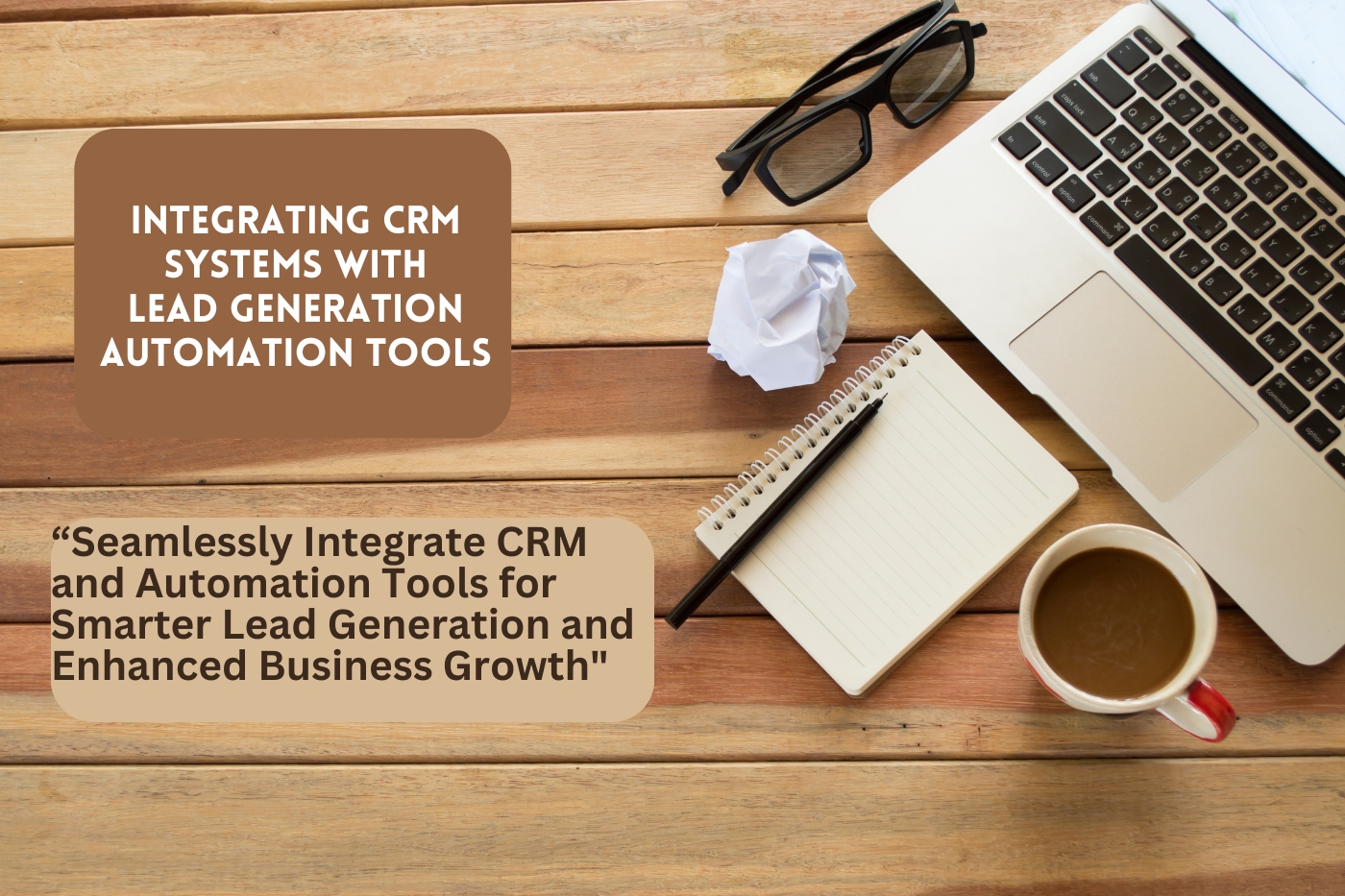Table of content
What is the Integration of CRM Systems with Lead Automation Tools?
CRM integration with lead automation tools is one such strategic step to enhance the efficiency of business processes, smooth customer interactions, and promote lead management processes inside the organization. A CRM system is essentially a software platform devised for management based on customer engagement, tracking sales information, and storing customer data. On the other hand, lead automation tools are those designed to automate the process of generation, nurturing, and management of all the required leads and so more attention is stricken towards prospects becoming customers.
Integrate CRM systems with lead automation tools and provide a user interface designed for lead capturing from their first prospect to a transformed customer. This leads to a smooth flow of information between the two systems, resulting in up-to-date and easily available customer information in a single user interface. This is equivalent to a more organized, efficient, and effective process of managing leads to yield better business outcomes.
How Does It Work?
With the integration of CRM systems and lead automation software, it needs to allow both platforms to be connected and work accordingly. Here's a step-by-step review of how this works:
1. Data Synchronization: This is the initial phase to integrate—to merge the data from the CRM system and the lead automation tool. Synchronization of data means that all the information entered into one system will automatically get updated in another. Wherever new leads are captured using the lead automation tool, they are instantly populated within the CRM system. The same applies when alterations are made within the CRM system, such as altering the status of a lead or changing contact information; such changes are also replicated on the lead automation tool.
2. Capture and Management of Leads: The leads automation tools must be able to capture leads from everywhere—either from the websites, social media, or email campaigns. Whenever a lead is captured, it automatically enters the CRM system. Then it goes on to assign the lead to a sales representative, commands their interactions, and oversees the progression of the lead through the sales funnel.
3. Lead Scoring and Segmentation: One of the most important features of the best lead automation tools is lead scoring. In this process, every lead has a score on the basis of the likelihood of him or her becoming a customer. This score is usually based on factors like their level of engagement, position in the sales funnel, and interaction history. The CRM system uses this scoring for lead prioritization, thus making the sales teams dedicated to high-quality leads. Additionally, the integration makes it possible to segment leads easily according to pre-set criteria, such as industry, location, or behavior, and it's highly practical for targeting them with personalized marketing campaigns.
4. Automated Workflows: Integration makes it possible to craft automated workflows, meaning the lead management process simply becomes faster. For example, when a lead reaches a certain score, it will trigger a pre-defined action item, like sending a follow-up email or setting up a sales call. Such automated workflows save time and ensure leads are well-nurtured without manual intervention.
5. Analytics and Reporting: Business integration builds stronger analytic and reporting abilities. Business information is consolidated from the CRM system with the help of lead automation tools to help businesses gain insights into the effectiveness of lead generation, the performance of sales, and customer interaction. Such insights help the companies to make data-driven decisions and hence streamline their sales and marketing strategies.
Benefits of Integrating CRM Systems with Lead Automation
Integrating CRM systems with lead automation tools offers innumerable benefits that, in turn, might influence the sales and marketing objectives of any business. Let's consider the most important ones:
1. Higher Efficiency and Productivity: By integrating CRM systems with lead automation tools, more elimination can be achieved from manual data entry while reducing errors. The sales team does not have to work on updating the records or trying to track the leads and follow-ups on a manual basis. Automated workflows execute repetitive jobs, which help the sales representative save time for other important activities like deal-making and relationship building. Efficiency breeds more productive results, and productive results ultimately lead to better business results.
2. Improved Lead Management: Lead management remains the key and first step to convert potential leads into customers. Integrating the CRM systems with advanced lead automation tools can help a business keep lead management more organized and streamlined. Organizes all lead details and gives those details to sales officers. Sales officers can get more done. The idea is that leads are better and change to sales more often. This results in increased conversion rates and better sales performance.
3. Personalized Customer Interactions: Personalization is key to a door leading to successful customer interaction. After integration, businesses start exploiting data not only from the CRM systems but also from the lead automation tools straightly for creating details in the marketing campaign and the blueprint of sales strategies. For instance, based on the analysis of the behavior of leads and the history of engagement, the business will be able to tune in its messaging to speak to the needs and pinpoint of this lead. It is this personalized approach that imparts efficiency in customer service, coupled with eliciting high conversion rates.
4. Better Coordination Among Sales and Marketing Teams: Integration also provides better coordination among sales and marketing teams, as both get unified platforms for collaboration. Both work on the same amount of data, which is proper cooperation. For instance, marketing teams may derive from the CRM system the insights they need so as to create targeted campaigns that resound with high-quality leads, whereas sales teams utilize both lead scores and segmentation data to really focus on leads most likely to convert. The same ensures that the two teams work toward common goals, and thus sales and marketing are more successful.
5. Real-Time Insights and Reporting: Integration can help realize the biggest opportunity—real-time insights and reporting. This enables organizations to track major key metrics such as lead conversion, sales performance, and customer interactions. Such information is very useful for making decisions and helps one tune sales and marketing strategies. This is important because, should one campaign be under-performing, a business can quickly find out what the problem is and do what may be needed to salvage their campaigns for the best results. Real-time insights also enable quick responses to changing market conditions and customer needs.
6. Scalability and Flexibility: As the business grows, the needs for lead generation and customer management evolve. Integration brings scalability and flexibility to adapt to these changing needs. It enables easy addition of new sources of leads, automation of additional workflows, and the scalability on CRM systems to fit the expanding client base. This would ensure that businesses can continue to offer a high standard of service with efficient processes for lead management as they grow.
7. Improved Customer Retention: Customer retention is as important as customer acquisition. Integration helps a business build better relations with its customers due to the overall view it gives across all customer interactions. Bringing visibility across functions empowers businesses to understand their customers' needs, be able to identify where they can do better, and serve them better in a proactive manner, going further to give individual experiences that make patrons come back time and again. Automated follow-ups and nurturing campaigns keep customers engaged and lower churn.
8. Cost Savings: Integrating CRM systems with lead automation tools can save a ton of costs. One of those is through automation that reduces manual labor, hence operation expenses, in the daily functionalities. Increasing automation not only reduces expenses but also increases ROI when there are more sales through good lead management and a higher conversion rate. Also, firms can better allocate resources, resulting in better management and cost saving through data-driven decision-making.
Conclusion
Integrating CRM systems with lead automation tools is one impactful strategy that businesses can adopt to transform the way leads are managed and the engagement attained with more customers. The integration of these elements streamlines the process of lead management, hence efficiency, while providing businesses with insights for informed decisions. In turn, having gained the benefits of integrating the business, it will be able to optimize sales and marketing initiatives to grow business and drive revenue while increasing customer satisfaction. Whether small businesses need to close leads faster or large companies need to do a better job at managing and optimizing customer interactions, this is where the tie between CRM systems and automation tools for leads comes into place.
Get your next meeting in a
matter of minutes.
Free Trial
Latest
The Ultimate LinkedIn Outreach Playbook 2025
A practical, modern guide to mastering LinkedIn outreach in 2025 — learn how to boost reply rates, p
12/1/2025How to Find 100 ICP Leads Without LinkedIn Sales Navigator
Generating 100 targeted ICP leads doesn’t require LinkedIn Sales Navigator. Learn how to leverage fr
11/28/2025


